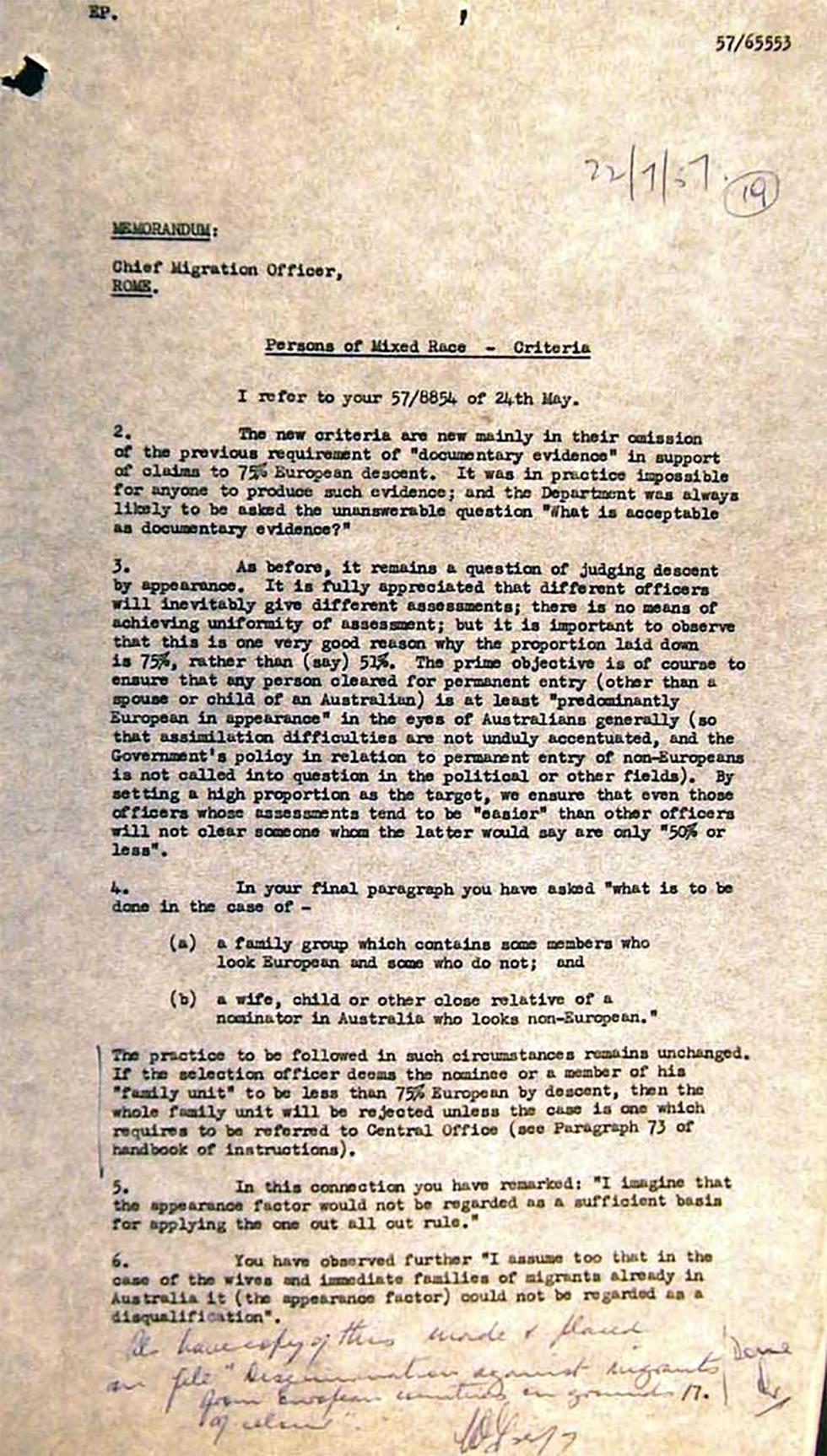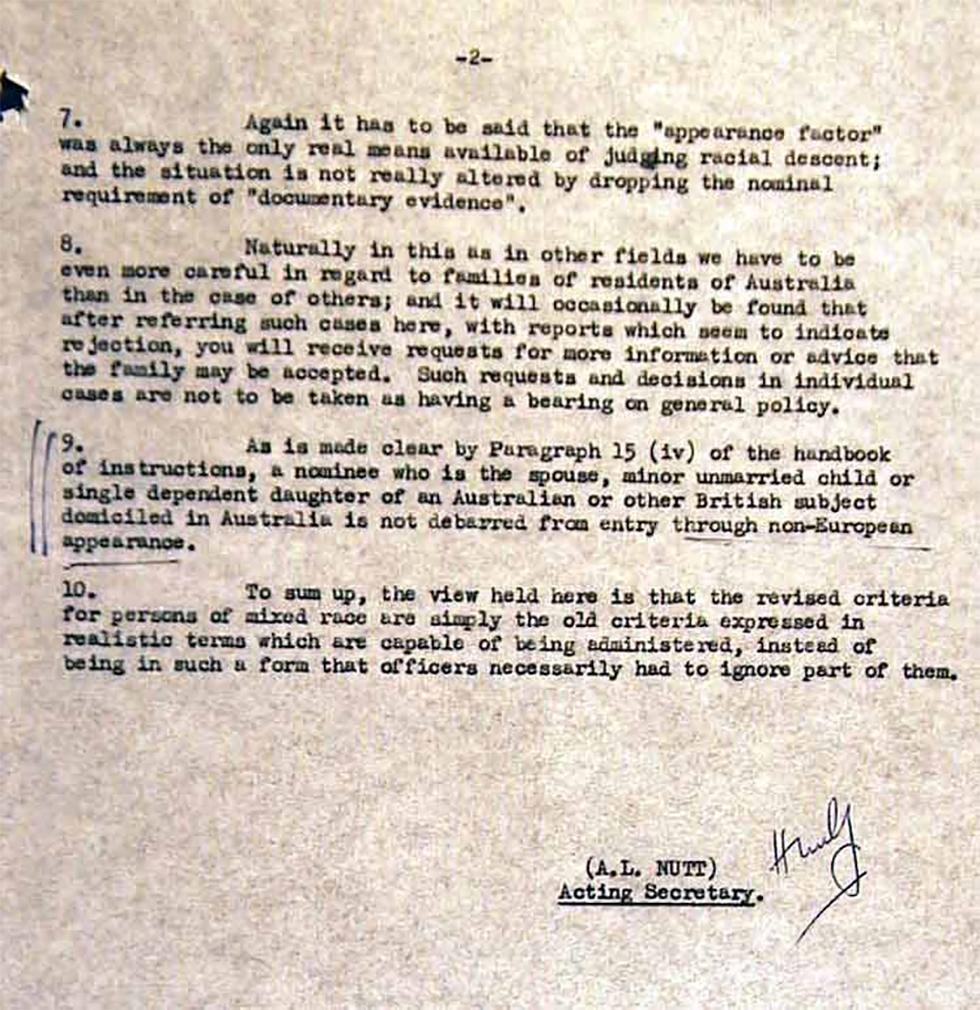
Memo for the Chief Migration Officer, Rome, describing flaws in judging descent based on appearance.

Memo for the Chief Migration Officer, Rome, describing flaws in judging descent based on appearance.
Aboriginal and Torres Strait Islander people should be aware that the National Archives' website and collection contain the names, images and voices of people who have died.
Some records include terms and views that are not appropriate today. They reflect the period in which they were created and are not the views of the National Archives.


Memo for the Chief Migration Officer, Rome, describing flaws in judging descent based on appearance.

Memo for the Chief Migration Officer, Rome, describing flaws in judging descent based on appearance.
[page 1]
EP.
57/65553
[Handwritten] 22/7/57.
['19', circled] [end handwritten]
MEMORANDUM: (underlined)
Chief Migration Officer,
ROME. (underlined)
Persons of Mixed Race – Criteria (underlined)
I refer to your 57/8854 of 24th May.
2. The new criteria are new mainly in their omission of the previous requirement of "documentary evidence" in support of the claims to 75% European descent. It was in practice impossible for anyone to produce such evidence; and the Department was always likely to be asked the unanswerable question "What is acceptable as documentary evidence?"
3. As before, it remains a question of judging descent by appearance. It is fully appreciated that different officers will inevitably give different assessments; there is no means of achieving uniformity of assessment: but it is important to observe that this is one very good reason why the proportion laid down is 75%, rather than (say) 51%. The prime objective is of course to ensure that any person cleared for permanent entry (other than a spouse or child of an Australian) is at least "predominantly European in appearance" in the eyes of Australians generally (so that assimilation difficulties are not unduly accentuated, and the Government's policy in relation to permanent entry of non-Europeans is not called into question in the political or other fields). By setting a high proportion as the target, we ensure that even those officers whose assessments tend to be "easier" than other officers will not clear someone whom the latter would say are only "50% of less".
4. In your final paragraph you have asked "what is to be done in the case of –
(a) a family group which contains some members who look European and some who do not; and
(b) a wife, child or other close relative of a nominator in Australia who looks non-European."
The practice to be followed in such circumstances remains unchanged. If the selection officer deems the nominee or a member of his "family unit" less than 75% European by descent, then the whole family unit will be rejected unless the case is one which requires to be referred to Central Office (see paragraph 73 of handbook of instructions).
5. In this connection you have remarked: "I imagine that the appearance factor would not be regarded as a sufficient basis for applying the one out all out rule."
6. You have observed further "I assume too that in the case of the wives and immediate families of migrants already in Australia it (the appearance factor) could not be regarded as a disqualification"
[handwritten, blue pen] I have copy of this [unclear] on file "Discrimination against migrants from European countries on grounds of colour".
[The word 'Done' is handwritten to the right of the handwritten paragraph, in blue pen, with two small arrows pointing towards the handwriting and the bottom right corner of the page]
[signature] [end on handwritten]
/7.
[end of page 1]
[page 2]
-2-
7. Again it has to be said that the "appearance factor" was always the only real means available of judging racial descent; and the situation is not really altered by dropping the nominal requirement of "documentary evidence".
8. Naturally in this as in other fields we have to be even more careful in regard to families of residents of Australia than in the case of others; and it will occasionally be found that after referring such case here, with reports which seems to indicate rejection, you will receive requests for more information or advice that the family may be accepted. Such requests ad decisions in individual cases are not to be taken as having or bearing on general policy.
9. As is made clear by Paragraph 15 (iv) of the handbook of instruction, a nominee who is the spouse, minor unmarried child or single dependent daughter of an Australian or other British subject domiciled in Australia is not debarred from entry through non-European appearance.
10. To sum up, the view held here is that the revised criteria for persons of mixed race are simply the old criteria expressed in realistic terms which are capable of being administered, instead of being in such a form that officers necessarily had to ignore part of them.
(A. L. Nutt)
Acting Secretary. [underlined]
[handwritten signature, blue pen]
Learn how to interpret primary sources, use our collection and more.
